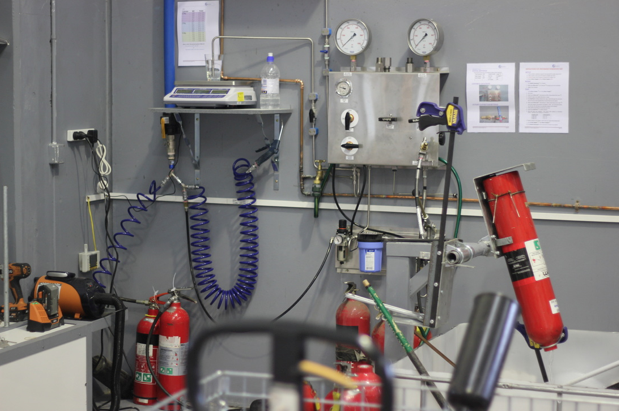
11 Apr 5 YEARLY FIRE EXTINGUISHER REFILL & PRESSURE TESTS
Whether your a small business owner or an employee of a large company, you need to trust that your workplace’s portable fire extinguishers will function properly for any fire situation or emergency. Once fire extinguishers are installed, there should be an ongoing maintenance schedule that includes regular inspections to keep your extinguishers ready and fully functional in the event of an emergency. 6 Monthly & Yearly testing to AS1851 is the best way to achieve this.
You may be tempted to perform your own fire extinguisher maintenance and inspections. This includes refilling fire extinguishers when necessary. Saving some money up front in this way includes risks and other issues when a facility manager decides to refill the workplace’s fire extinguishers. Time may be a cost when checking fire extinguishers to determine their functional status and performing the refill process properly. Even more importantly, if the refill process is not done adequately, then the extinguisher could malfunction in an emergency. In addition, handling pressurised chemicals in the refill process is a task that should be done by a trained professional.
Make sure your fire extinguishers are in compliance with Australian Standard AS-1851, which details the importance of having your fire extinguishers inspected, maintained and refilled when necessary. Letting a trained professional perform these tasks will help ensure that your facility remains in compliance with Australian Standards and that your fire extinguishers stand ready to work properly.
The maintenance tags indicate when fire extinguishers are due to be inspected, tested and refilled. This schedule is based upon Australian Standards, manufacturer specifications and the extinguishers last refill date. Keep the following in mind for indications of the need for refilling your fire extinguishers:
– The pressure indicator drops below a satisfactory operating level.
– Damage to the fire extinguisher may affect its pressure or operating capability.
– Corrosion found around the fire extinguisher could cause leakage.
– Potentially harsh environmental conditions may affect the pressure of your fire extinguisher, including excess dust or dirt, moisture or humidity, vibrations from heavy equipment or extreme temperatures.
– Briefly or accidentally discharged fire extinguishers; even a small discharge of pressurised operations and propellant gas used from extinguishers can cause units to degas and then lose ability to function properly.
The facility manager needs to have a trained professional like Sydney Extinguishers to inspect each fire extinguisher properly to determine the safety needs and to refill fire extinguishers when necessary. A trained professional will know how to handle filling extinguishers when not all fire extinguishers use the same refill chemicals. Extinguishers can use foam, liquids, powder, or gas. Accurately identifying the type of fire extinguisher is important to correctly determine refill requirements and inspection schedules in order to successfully carry out the refill process
Sydney Extinguishers recommends that due to the labor costs in Australia you swap powder extinguishers with new and refill & pressure tests Co2 only. We have a SWAP & GO system in place so they can be swapped on the day to ensure you are not left without any and are not waiting weeks for them to return. All old fire extinguishers are removed from site at no charge and then recycled or refilled & pressure tested
To comply with Australian Standards while keeping your property and personnel safe, make sure you have a certified professional like the lads at Sydney Extinguishers so that you comfortably know that your fire extinguishers are refilled properly. 6 Monthly and Annual Fire Safety Inspections and Statements are important for your insurance.
